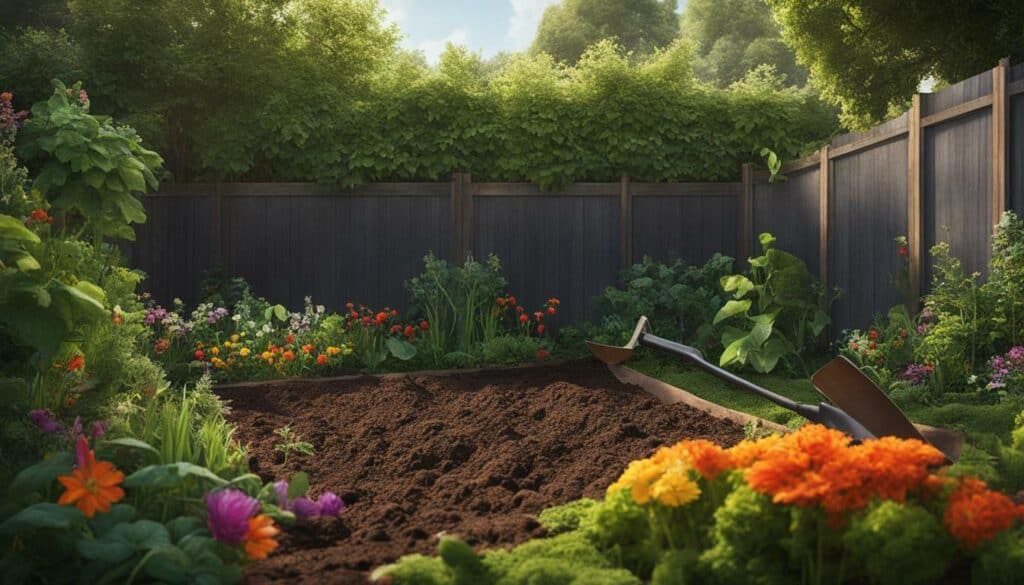As a green thumb expert, I have gathered five essential tips to help you improve the health and beauty of your lawn and gardens. Gardening is not just about nurturing plants; it’s about creating a stunning outdoor space that brings joy and relaxation to your life. Whether you’re a seasoned gardener or a beginner, these tips will help you maintain a healthy lawn, effective garden care, and elevate your gardening game.
- Prepare your garden for high summer temperatures by keeping soil in the ground, blocking wind, and selecting heat-tolerant plant varieties.
- Efficient watering techniques, like drip irrigation and soaker hoses with timers, can ensure your plants thrive.
- Provide shade and protection from the sun using shade cloth, pergolas, trees, or hedges, and consider using technology to monitor and adjust watering schedules.
- Start small with a few fruits, vegetables, or herbs that align with your preferences and carefully plan your garden layout.
- Join a gardening club for support and advice, embrace curiosity and experimentation, and create a relaxing outdoor space with seating areas.
By following these tips, you can transform your lawn and gardens into vibrant, healthy, and inviting spaces that you’ll be proud of. So, let’s get started on your gardening journey and watch your outdoor oasis flourish!
Overcoming High Summer Temperatures in Your Garden
Gardening in high summer temperatures requires special care and attention to ensure the health and vitality of your plants. The heat can quickly evaporate water from the soil, leaving plants dehydrated and stressed. However, with the right techniques and precautions, you can overcome these challenges and create a thriving garden.
| Techniques to Overcome High Summer Temperatures | Benefits |
|---|---|
| Prepare for high heat | Protects plants from heat stress and promotes healthy growth. |
| Keep soil in the ground | Helps retain moisture and prevents soil erosion. |
| Block wind | Reduces water evaporation and shields plants from drying winds. |
| Efficient watering | Ensures plants receive adequate moisture without wasting water. |
| Select heat-tolerant plant varieties | Allows plants to thrive in high temperatures and limited water conditions. |
When it comes to selecting heat-tolerant plants, consider varieties such as salvias, lantana, sedum, viburnum, zinnia, butterfly bush, cotoneaster, juniper, and pines. These plants are known for their resilience and ability to withstand hot temperatures. While they are drought-tolerant, it is still important to provide them with regular watering to ensure their well-being.
In terms of watering techniques, hand watering can be time-consuming and may lead to water wastage and leaf burns if water gets on the foliage. Drip irrigation, on the other hand, is an efficient method that delivers water directly to the root zone of plants, reducing water loss through evaporation. Soaker hoses are easy to install and can be paired with timers or smart watering systems for automated and precise watering.
Additionally, providing shade covers and wind barriers in your garden can protect plants from the sun’s intense heat and drying winds. Shade cloth, pergolas, awnings, trees, and hedges can be effective solutions. Technology, such as soil humidity sensors and smart timers, can be utilized to monitor soil moisture levels and adjust watering schedules accordingly.
Heat-Tolerant Plants for a Thriving Garden
When it comes to creating a garden that can withstand the heat, choosing the right plant varieties is essential. Heat-tolerant plants are designed to thrive in high temperatures and can withstand the challenges that summer brings. Here are some heat-tolerant plant varieties that are perfect for ensuring a thriving garden even in hot weather:
| Plant Variety | Drought Tolerance |
|---|---|
| Salvias | High |
| Lantana | High |
| Sedum | Medium |
| Viburnum | Medium |
| Zinnia | Medium |
| Butterfly Bush | Medium |
| Cotoneaster | Low |
| Juniper | Low |
| Pines | Low |
These plants not only tolerate high temperatures but also have varying levels of drought tolerance. While they can survive with minimal water, it’s important to note that they still require water to thrive. So, regular watering is necessary even for heat-tolerant plants.
To keep your plants healthy and vibrant, efficient watering techniques are key. Consider using drip irrigation, which efficiently waters the root zone of plants, or soaker hoses paired with timers or smart watering systems. These methods ensure that plants receive the right amount of water without wasting any. Additionally, providing shade covers and wind barriers can protect your plants from the intense heat and drying winds that often accompany high temperatures. Monitoring the soil humidity and adjusting the watering schedule accordingly using technology like soil humidity sensors and smart timers can also contribute to maintaining a healthy garden.

“Choosing heat-tolerant plants is like investing in a durable and sustainable garden. These plants can handle the scorching heat and still beautify your outdoor space. So, go ahead and create a garden that thrives even when the temperature rises!” – Green Thumb Expert
Efficient Watering Techniques for Healthy Plants
Proper watering is crucial for maintaining healthy plants in your lawn and garden. It is important to find the right balance between underwatering and overwatering to avoid stress or damage to your plants. Here are some efficient watering techniques to help you keep your plants happy and thriving:
1. Drip Irrigation
Drip irrigation is a highly efficient watering method that delivers water directly to the root zone of plants. It involves the use of tubing with tiny holes or emitters that release water slowly and evenly. This ensures that water reaches the plants’ roots without wastage or evaporation. Drip irrigation also reduces the risk of fungal diseases by minimizing water contact with the leaves.
2. Soaker Hoses
Soaker hoses are another effective option for watering your plants. These hoses have small pores or perforations that allow water to seep slowly into the soil along the entire length of the hose. They can be laid on the ground around your plants, delivering water directly to the root zone. Soaker hoses are easy to install, cost-effective, and help conserve water by reducing runoff and evaporation.
3. Smart Watering Systems
Smart watering systems utilize technology to automate and optimize your watering schedule. These systems use sensors to monitor soil moisture levels and weather conditions, adjusting the watering schedule accordingly. Some smart watering systems can even be controlled remotely through smartphone apps, allowing you to efficiently manage water usage even when you’re away from home.

Remember to water your plants deeply and less frequently, rather than shallow and frequent watering. This encourages the development of deep root systems, making the plants more resilient to drought conditions. Additionally, consider watering in the early morning or late evening when evaporation rates are low, allowing the plants to absorb water more effectively.
By implementing these efficient watering techniques, you can ensure that your plants receive the right amount of water they need, promoting their overall health and growth. Combine these techniques with proper soil preparation and mulching for even better results in your lawn and garden care.
Providing Shade and Protection from the Sun
Shielding your plants from the sun’s intense heat is crucial for their survival and growth. High temperatures can cause dehydration and stress, leading to wilting and damage. To ensure your garden thrives even in the hottest summer months, consider the following tips:
- Shade covers: Install shade cloth, pergolas, awnings, or even strategically planted trees to provide relief from direct sunlight. Not only will this protect your plants from the scorching rays, but it will also create a cool and inviting atmosphere.
- Wind barriers: Drying winds can exacerbate the effects of heat on your plants. Consider planting hedges or installing shade cloth as wind barriers to shield your garden and maintain a more favorable microclimate.
- Technology: Take advantage of modern technology to monitor and adjust your watering schedule. Soil humidity sensors can help you track moisture levels, while smart timers enable you to automate and optimize your watering routine, ensuring your plants receive adequate hydration.
Remember, different plants have varying tolerances to heat, so it’s essential to choose heat-tolerant varieties that can withstand the intensity of the sun. By providing protection and optimizing watering, you’ll create an environment where your plants can flourish, even in the hottest weather.

| Plant | Tolerance |
|---|---|
| Salvias | High |
| Lantana | High |
| Sedum | High |
| Viburnum | Medium |
| Zinnia | Medium |
| Butterfly Bush | Medium |
| Cotoneaster | Low |
| Juniper | Low |
| Pines | Low |
“A garden is a grand teacher. It teaches patience and careful watchfulness; it teaches industry and thrift; above all, it teaches entire trust.” – Gertrude Jekyll
By implementing these tips, you’ll create a haven for your plants in the face of soaring temperatures. Shielding them from the sun’s intense heat, whether through shade covers or wind barriers, will ensure their survival and promote healthy growth. With the right plant selection and innovative technology, you’ll be able to create an outdoor space that is not only beautiful but also resilient in the face of summer’s heat.
Starting a Small Garden for Beginners
If you’re new to gardening, starting small is the key to success. It allows you to learn and experiment without feeling overwhelmed. Here are some tips to help you get started:
- Choose plants that align with your preferences and gardening needs. Consider the amount of space you have, the type of soil, the amount of sunlight, and the water requirements of different plants. This will help you select plants that will thrive in your garden.
- Carefully plan and design your garden layout. Take into account the size of the plants, their growth habits, and their spacing requirements. This will ensure that your garden looks aesthetically pleasing and allows enough room for each plant to grow.
- Effective watering is crucial for the success of your garden. Make sure to water your plants regularly, but avoid overwatering which can lead to root rot. Consider using a soaker hose or drip irrigation system to provide water directly to the roots of the plants, ensuring efficient and targeted watering.
Remember to start small and gradually expand your garden as you gain more experience and confidence. Gardening is a continuous learning process, so don’t be afraid to make mistakes and try new things. Enjoy the journey and watch as your small garden grows into a beautiful and thriving oasis.
Joining a Gardening Club for Support and Advice
Joining a gardening club can significantly enhance your gardening journey. It provides a platform to connect with fellow gardeners who share the same passion and can offer valuable advice and support. By joining a club, you gain access to a wealth of knowledge and expertise that can help you become a better gardener.
One of the main benefits of joining a gardening club is the opportunity to learn from experienced gardeners. These seasoned experts have a wealth of knowledge and are often more than willing to share their tips and tricks. They can offer guidance on plant selection, soil preparation, pest control, and other important aspects of gardening. By tapping into their expertise, you can avoid common pitfalls and achieve better results in your own garden.
Another advantage of joining a gardening club is the sense of community it provides. Gardening can sometimes be a solitary hobby, but being part of a club allows you to connect with others who share your love for plants and outdoor spaces. You can share stories, swap seeds or plants, and even participate in organized events or workshops. The camaraderie and support from fellow members can be motivating and inspiring, keeping your enthusiasm for gardening alive.
So, if you’re looking to take your gardening skills to the next level and surround yourself with like-minded individuals, consider joining a gardening club. It’s an investment that will pay off in terms of knowledge, inspiration, and the joy of being part of a thriving gardening community.

Embracing Curiosity and Experimentation in Gardening
Don’t be afraid to step out of your comfort zone and experiment with new plants and gardening techniques. Gardening is a wonderful opportunity to explore your creativity and discover new favorites. Whether it’s trying out unique plant varieties or testing different methods of cultivation, embracing curiosity in your garden can lead to exciting discoveries.
One way to satisfy your curiosity is by experimenting with different types of plants. Research what plants are suitable for your climate and soil conditions, and then try planting something unusual or unexpected. It could be a vibrant flowering plant that catches your eye, or a vegetable or herb that you’ve never tasted before. The possibilities are endless, and you might just find a new favorite that adds a delightful touch to your garden.
Another area to explore is experimenting with various gardening techniques. You may want to test out different methods of propagation, such as rooting cuttings or starting seeds indoors. You could also try different cultivation techniques, like companion planting or raised bed gardening. By being open to experimentation, you can find what works best for you and your garden, and may even uncover some innovative approaches that lead to better results.
Quotes:
“Gardening is an opportunity for endless discovery and learning. Embracing curiosity and experimenting with new plants and techniques can make the journey even more enjoyable.” – Me
So, go ahead and let your curiosity take root in your garden. Explore new plants, techniques, and styles, and see what surprises await you. Remember, gardening is not only about the end result but also about the joy of the process and the continuous learning it brings. Happy gardening!
| Benefits of Embracing Curiosity and Experimentation |
|---|
| 1. Discover new and unique plants that add excitement to your garden. |
| 2. Learn and develop new gardening techniques that suit your style and preferences. |
| 3. Find innovative solutions to common gardening challenges. |
| 4. Enjoy the process of continuous learning and discovery in your gardening journey. |

Creating a Relaxing Outdoor Space with Seating Areas
Your garden can be transformed into a serene sanctuary by incorporating a well-designed seating area. A comfortable and inviting space allows you to fully enjoy the beauty of your surroundings and unwind in the tranquility of nature. Whether you have a small balcony or a sprawling backyard, here are some tips to help you create the perfect seating area for your garden:
- Choose the right location: Select an area that offers a balance of sunlight and shade, depending on your preferences. Consider the views, privacy, and proximity to other elements of your garden.
- Select suitable furniture: Opt for weather-resistant materials that can withstand the elements. Choose comfortable seating options such as lounge chairs, benches, or hammocks, and add cushions and throw pillows for extra coziness.
- Create a focal point: Incorporate a centerpiece, such as a water feature, fire pit, or sculpture, to add visual interest and create a relaxing ambiance.
- Add shade and privacy: Use pergolas, umbrellas, or shade sails to provide shade from the sun. Consider installing a trellis or bamboo screens to create a sense of seclusion and privacy.
- Accessorize with plants and decor: Integrate plants, flowers, and potted herbs to add a touch of nature. Use outdoor rugs, lanterns, and string lights to enhance the atmosphere and create a cozy, inviting space.
Remember to maintain your seating area by regularly cleaning and protecting your furniture from the elements. With the right design and attention to detail, your garden seating area can become a tranquil retreat where you can relax, read a book, entertain guests, or simply enjoy the beauty of your outdoor space.

Make your garden seating area a haven of relaxation and comfort. Incorporate these tips to create an inviting space that reflects your personal style and provides a peaceful escape from the busyness of everyday life.
Enhancing Soil Quality with Compost and No-Till Gardening
Building healthy soil is the foundation for a successful garden. By enriching the soil with organic matter and adopting sustainable gardening practices, you can create a thriving ecosystem for your plants. Two effective methods for enhancing soil quality are composting and practicing no-till gardening.

Composting involves collecting and decomposing organic materials such as kitchen scraps, yard waste, and leaves. As these materials break down, they release nutrients that nourish the soil and support plant growth. Compost also improves soil structure, allowing for better water retention and drainage.
No-till gardening is a technique that minimizes disturbance to the soil, preserving its natural structure and beneficial microorganisms. Instead of tilling or turning the soil, organic matter is added on top as mulch, creating a protective layer that retains moisture and prevents weed growth. This method promotes soil health and reduces erosion.
Both composting and no-till gardening offer numerous benefits for maintaining a healthy lawn and improving overall garden health. Incorporating compost into your soil will provide essential nutrients and enhance its ability to hold moisture. By practicing no-till gardening, you can minimize soil erosion, conserve water, and create a favorable environment for beneficial organisms.
Summary:
- Building healthy soil is crucial for a successful garden.
- Composting enriches the soil with organic matter and nutrients.
- No-till gardening preserves soil structure and minimizes erosion.
- Compost improves soil fertility and water retention.
- No-till gardening conserves water and supports beneficial organisms.
| Advantages of Composting | Advantages of No-Till Gardening |
|---|---|
| Enriches soil with nutrients | Preserves soil structure |
| Improves soil water retention and drainage | Reduces soil erosion |
| Enhances soil fertility | Conserves water |
| Supports beneficial microorganisms | Fosters a favorable environment for plants |
By incorporating compost and embracing no-till gardening, you can create nutrient-rich soil that supports the growth of healthy plants in your garden. These sustainable practices contribute to maintaining a healthy lawn and improving overall garden health for years to come.
Adding Fun and Uniqueness with Interesting Plant Varieties
Spice up your garden with unusual and captivating plant varieties. Adding unique plants to your garden not only adds visual interest but also creates a sense of wonder and excitement. Here are some tips to help you choose interesting plant varieties:
- Research: Before selecting plants, do some research to determine which varieties will thrive in your specific climate and soil conditions. Consider factors such as sunlight requirements, water needs, and temperature tolerance.
- Native Plants: Consider incorporating native plants into your garden. Native plants are well-suited to the local environment and often attract beneficial insects and wildlife.
- Uncommon Species: Look for plant varieties that are less commonly seen in gardens. These unique species can add a touch of the extraordinary to your outdoor space.
- Colorful Blooms: Choose plants with vibrant and unusual colored blooms to create eye-catching focal points in your garden. From bold purples and blues to fiery oranges and reds, opt for plants that will make a statement.
- Foliage Varieties: Don’t overlook the power of interesting foliage. Select plants with unique leaf shapes, textures, or colors to add depth and visual interest to your garden.
Remember, experimentation is key. Don’t be afraid to try new plants and combinations in your garden. By incorporating interesting and unusual plant varieties, you can create a garden that is truly one-of-a-kind.

Conclusion on Lawn and Gardens
By implementing these 5 tips, you can transform your lawn and garden into vibrant and thriving spaces that you can enjoy for years to come. Gardening in high summer temperatures can be challenging, but with the right techniques and plant selections, you can overcome these obstacles. Preparing for high heat, protecting the soil, and selecting heat-tolerant plant varieties are essential for maintaining a healthy garden.
Some plants, like salvias, lantana, and sedum, are known for their ability to tolerate hot temperatures and drought conditions. However, even heat-tolerant plants require regular watering to thrive. Efficient watering techniques, such as drip irrigation or soaker hoses paired with timers, can ensure that your plants receive the right amount of water without wasting resources.
To protect your plants from the intense heat of the sun, consider providing shade covers and wind barriers. Shade cloth, pergolas, awnings, and trees can offer relief from the sun’s rays, while hedges or shade cloth can shield plants from drying winds. Utilizing technology, like soil humidity sensors and smart timers, can further optimize your watering schedule and ensure your plants’ health.
When starting a small garden, focus on a few fruits, vegetables, or herbs that align with your preferences. Consider the space, soil, sunlight, and water requirements of your chosen plants, and plan your garden layout accordingly. Effective watering techniques, such as hand watering or drip irrigation, will contribute to the success of your garden.
Remember to join a gardening club or connect with other gardeners for support, advice, and inspiration. Embrace curiosity and experiment with new plants, techniques, and gardening styles. Create a relaxing outdoor space by adding seating areas or other features that reflect your style and provide a comfortable haven for relaxation. Enhance soil quality by incorporating compost and practicing no-till gardening, and add fun and uniqueness to your garden with interesting plant varieties that suit your climate and soil conditions.
By following these tips and continuously learning about the art of gardening, you can create a stunning outdoor oasis that brings beauty and joy to your life. Happy gardening!
FAQ on Lawn and Gardens
Q: What can I do to help my plants survive in high summer temperatures?
A: To help your plants survive in high summer temperatures, focus on techniques such as preparing for high heat, keeping soil in the ground, blocking wind, efficient watering, and selecting plant varieties that can withstand hot temperatures.
Q: Which plant varieties can tolerate high heat?
A: Some plant varieties that can tolerate high heat include salvias, lantana, sedum, viburnum, zinnia, butterfly bush, cotoneaster, juniper, and pines. These plants are drought-tolerant but still require water to thrive.
Q: What are some efficient watering techniques for healthy plants?
A: Drip irrigation is an efficient watering technique that waters the root zone of plants. Soaker hoses are also easy to install and can be paired with a timer or smart watering system. Hand watering should be avoided as it can be labor-intensive and may burn plants if water gets on their leaves.
Q: How can I protect my plants from the sun’s intense heat?
A: You can provide shade covers such as shade cloth, pergolas, awnings, or trees to protect plants from the sun’s intense heat. Wind barriers like hedges or shade cloth can also help protect plants from drying winds. Technology, such as soil humidity sensors and smart timers, can be used to monitor and adjust the watering schedule.
Q: What are some tips for starting a small garden for beginners?
A: To start a small garden, focus on a few fruits, vegetables, or herbs that you enjoy eating. Consider your gardening needs, such as space, soil, sunlight, water, and protection from threats. Plan your garden carefully, design the layout, and make sure to water effectively.
Q: Are there any additional tips for improving my lawn and garden?
A: Yes! Joining a gardening club or connecting with other gardeners can provide valuable advice and support. Embrace curiosity and experimentation in your gardening endeavors. Consider creating a seating area or other features to make your garden a space you want to spend time in. Use compost to improve soil quality and practice no-till gardening. Lastly, try interesting plant varieties for some fun and unique touches in your garden.





Leave a Reply